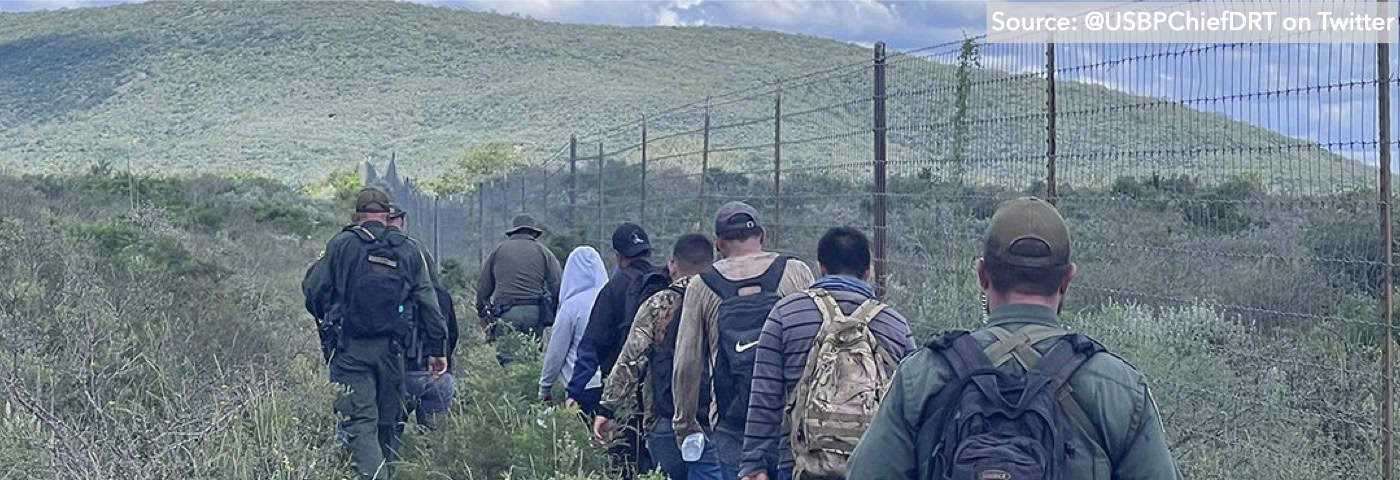Travel
Weekly U.S.-Mexico Border Update: Asylum executive order, Mexico crackdown, Border Patrol centennial, South America migration – WOLA

With this series of weekly updates, WOLA seeks to cover the most important developments at the U.S.-Mexico border. See past weekly updates here.
Due to an extended period of staff travel and commitments, we will produce Weekly Border Updates irregularly for the next two and a half months. We will resume a regular weekly schedule on July 26.
Support ad-free, paywall-free Weekly Border Updates. Your donation to WOLA is crucial to sustain this effort. Please contribute now and support our work.
THIS WEEK IN BRIEF:
After failing twice to enact such a measure through legislation, the Biden administration appears poised to issue an executive order that would allow U.S. border authorities to turn back or deport asylum seekers whenever the number of arriving migrants exceeds a specific threshold. The legal authority on which such an executive order would be based appears shaky, and there is a significant probability that it would not withstand challenges in the judicial system.
Mexico’s government reported encountering or stopping 120,879 migrants during the month of April, a record that only slightly exceeds similar numbers reported every month since January. Well over half of April’s total were citizens of South American nations. Mexico’s stepped-up efforts to block migrants, which appear to involve aggressive busing into the country’s interior more than deportations or detentions, have left large numbers of migrants stranded there amid a notable drop in U.S. authorities’ migrant encounters.
The U.S. Border Patrol was founded 100 years ago this week. Some analyses of the milestone have focused on the agency’s checkered human rights record. The Southern Border Communities Coalition and congressional Democrats, drawing attention to a recent GAO report’s findings, voiced concern that reforms aimed at more impartial oversight of use-of-force cases aren’t going far enough.
Colombia voices skepticism about Panama’s new president’s promise to shut down Darién Gap migration. UNHCR data continue to show that many Venezuelan migrants in the Darién first sought to settle elsewhere in South America. Ecuadorians are skipping the Darién route by flying to El Salvador.
THE FULL UPDATE:
An executive order limiting asylum access could come as early as next week
The Biden administration appears close to issuing an executive action that, when daily migration exceeds a certain level, would deny or severely limit the right to seek asylum for migrants apprehended on the U.S. side of the border with Mexico. Reports are converging on Tuesday (June 4) as a likely release date, though they caution that it continues to be a matter of internal White House discussion.
This “asylum shutdown” order would U.S. authorities to deport asylum seekers without affording them a chance to seek protection, perhaps making exceptions for those who can prove a very high threshold of fear of return. It would reportedly be triggered when U.S. authorities’ daily average of migrant encounters reaches 4,000 or 5,000, possibly including appointments made at ports of entry. Where possible, U.S. border authorities would deport migrants to Mexico after denying asylum access.
At busy moments along the border, then, the executive order would institute a policy similar to the pandemic-era Title 42 expulsions regime.
As part of a larger package of border-related measures, leadership of the U.S. Senate’s Democratic majority tried twice this year, without success, to add such an “asylum shutdown” authority to U.S. law on a temporary basis. (See WOLA’s February 9 and May 24 Border Updates, among others in the past six months.)
Without that law authorizing it, it is not clear how the Biden administration could use executive authority to abridge asylum at the border in this way. If President Biden “were to try to shut down portions of the border, the courts would throw that out, I think, within a matter of weeks,” Sen. Chris Murphy (D-Connecticut), Senate Democrats’ chief architect of the unsuccessful border legislation, told CBS News’s Face the Nation.
Press reports indicate that the administration may resort to using Section 212(f) of the Immigration and Nationality Act (INA), which allows the President to bar the entry of a class of non-citizens considered “detrimental to the interests of the United States.” However, courts have cast doubt on whether 212(f) can in fact be used to remove an asylum seeker already on U.S. soil and asking for protection. Section 208 of the INA allows non-citizens to ask for asylum if they are “physically present” in the United States, regardless of how they arrived. (The Trump and Biden administrations’ Title 42 policy did allow expulsions of asylum seekers on public health grounds; federal courts did not agree with this but the policy expired before all appeals were exhausted.)
Earlier reporting, as WOLA’s May 24 Border Update reported, was already pointing to the White House issuing the order soon, after Mexico’s June 2 presidential elections. “The White House and a White House official told me that no final decisions have been made about an executive action that is potentially being considered,” reported PBS NewsHour’s Laura Barron-Lopez on May 28. “But sources told me that this specific executive action could come as early as next week after the Mexican elections on June 2.”
The “Mexican elections” milestone is no accident, as executing the order would depend on Mexico taking more U.S. returns of non-Mexican citizens. Mexico currently accepts U.S. deportations of up to 30,000 citizens of Cuba, Haiti, Nicaragua, and Venezuela every month under a May 2023 Biden administration rule, currently facing judicial challenges, that denies asylum to migrants who cross the border between ports of entry without having sought it elsewhere along their migration route.
Mexico’s recent cooperation extends to a big jump in migrant apprehensions and other stepped-up efforts to block routes to the U.S. border this year, as discussed in the next section below. It is not clear, though, whether Mexico’s government—which strongly opposed a restart of the Trump-era “Remain in Mexico” policy—would agree to take back a greater number of U.S. cross-border deportees under a new executive order. (U.S. aerial deportation, a costly program, is meanwhile unlikely to expand dramatically.)
Administration officials and some centrist Democrats continue calling for new limits on asylum. “The reality is that some people do indeed try to game the [asylum] system,” Homeland Security Secretary Alejandro Mayorkas told CBS News in an interview that aired May 28. “That does not speak to everyone whom we encounter, but there is an element of it, and we deal with it accordingly.” A CNN analysis meanwhile noted how Democratic legislators and candidates in tight races tend to favor placing limits on asylum at the border.
For fourth straight month, Mexico encounters almost exactly 120,000 migrants
A year ago, Mexico’s authorities had never reported stopping (apprehending or “encountering”) more than 52,201 migrants in a month—a record set in October 2022. By November 2023, Mexico had shattered that record, stopping 97,969 migrants.
Now, Mexico has left even that record far behind. In April, for the fourth straight month, Mexico’s Migration Policy Unit reported encountering almost exactly 120,000 migrants. The 481,025 migrants Mexico reports stopping or encountering between January and April represent a 231 percent increase over the same period in 2023.
As has been typical in recent months, about one-third of Mexico’s April migrant encounters have been with citizens of Venezuela. In fact, the top three positions were South American nationalities: 10 percent were Ecuadorian and 8 percent were Colombian. Of all 120,879 of Mexico’s April encounters, 57 percent were with migrants from the South American continent. 7 percent were from countries in Asia (4,362) or Africa (4,291).

Of all nationalities with more than 1,000 April encounters, 3 have more than doubled in encounters since December 2023: Peru (+318%), Colombia (+217%), and El Salvador (+140%). El Salvador is the fastest-growing Central American nationality despite the reported popularity of its newly re-inaugurated president, Nayib Bukele.
Even as Mexico’s government reports encountering or stopping a record number of migrants, it has kept deportations to a minimum. It reported removing 1,779 migrants in April, 85 percent of them citizens of Guatemala and Honduras, and 10,427 so far this year (88% from Guatemala and Honduras). Mexico reports deporting one migrant for every 46 migrants encountered; in 2022 the ratio was one deportee for every 3.6 encounters.
Mexico has meanwhile all but ceased handing out humanitarian visitor cards (Tarjetas de Visitante por Razones Humanitarias or TVRH), a document that some migrants used in the past to travel to the U.S. border. The Migration Policy Unit reports that Mexico furnished 888 humanitarian cards in the first 4 months of the year, down 98 percent from 51,095 in the first 4 months of 2023.
Record encounters, along with minimal deportations and transit documents, indicate that Mexico probably has an unprecedented number of migrants in its territory. Media continue to report about the government’s policy of busing large numbers of migrants, relocating them in the country’s south and elsewhere in its interior, far from the U.S. border. It is unclear how long Mexico can keep this up, or how long migrants stranded in the country will tolerate it. But for now, it has brought a notable reduction in the number of people reaching the U.S.-Mexico border.
On Border Patrol’s 100th anniversary, advocates focus on oversight and accountability
The U.S. Border Patrol was founded 100 years ago this week, in 1924. Much coverage of the anniversary has focused on the agency’s complicated history.
The force’s current chief, Jason Owens, looked back on his career and told CBP’s Frontline magazine website that people considering a career as an agent should fully commit to it as a “calling.” Owens described tools using AI technology as a “force multiplier” for agents in the field. He added, “It would be so much better if the migrants went to the port of entry.” (CBP has capped port of entry capacity to receive asylum seekers at 1,450 people per day border-wide.)
A Mother Jones analysis highlighted aspects of the agency’s founding, at the urging of Texas Congressman Claude Benton Hudspeth, that reflect political and social tensions and contradictions about U.S. border security and immigration that remain in place today. “Chaos is not just the absence of a border; it is also the consequence of trying to maintain one,” noted the piece’s author, Tim Murphy.
“Revelations of some agents’ racist vitriol toward migrants, along with allegations of sexual misconduct against women employees, have rocked public trust in recent years,” noted a Christian Science Monitor analysis of Border Patrol’s centennial.
The Southern Border Communities Coalition commemorated the anniversary with a press conference in San Diego with loved ones of people killed, wounded, or racially profiled by agency personnel, none of whom has paid a penalty. The Coalition voiced skepticism about whether recent reforms, like the abolition of “Critical Incident Teams” that interfered with past investigations, are enough to achieve justice when Border Patrol agents commit human rights abuses.
Three San Diego-area House Democrats, along with Texas Rep. Joaquín Castro, sent a letter to leadership of DHS and CBP with questions about oversight of Border Patrol in human rights cases. Castro and Reps. Juan Vargas, Sara Jacobs, and Scott Peters called on the border agencies to follow recommendations in a May 13 Government Accountability Office (GAO) report, which found that Border Patrol’s Office of Professional Responsibility needed to improve the independence and impartiality of personnel investigating critical use-of-force incidents.
4,281 Border Patrol agents left the agency between October 2020 and April 2024, an annual attrition rate of about 6 percent, according to data obtained through the Freedom of Information Act by Anna Giaritelli of the conservative Washington Examiner. As Border Patrol underwent a surge of hiring in the years after September 11, 2001, a large number of agents are completing 20 years on the force and will soon be eligible for retirement, Giaritelli noted.
The article cited unnamed agents blaming the Biden administration for low morale; many say morale is low because they must release many apprehended migrants instead of detaining them.
South America migration updates
- Colombia “would not agree with” Panamanian President-Elect José Raúl Mulino’s campaign promise to shut down the Darién Gap by deporting migrants who cross the treacherous jungle route straddling the two countries’ border, said Foreign Minister Luis Gilberto Murillo. Instead, “what we have to offer is more humanitarian outlets for this population that crosses through that area.” The Colombian news site Cambio looked at the logistical, human rights, and practical obstacles that would stand in the way of “shutting down” the Darién.
- The Ecuadorian daily Primicias reported on the increasing number of northbound Ecuadorian citizens who are avoiding the Darién Gap by flying to El Salvador, which does not require visas of visiting Ecuadorians. “Between January and April 2024, 43,408 travelers have left Ecuador [for El Salvador] and 4,112 have returned.” While seeking to migrate northward after arriving, many are subject to bribery, shakedowns, and mistreatment by Salvadoran and other corrupt Central American officials.
- Of 128 migrants transiting Panama interviewed by UNHCR earlier this month, 69 percent were from Venezuela, and of these, half came directly from Venezuela. Of the half of Venezuelans who had sought to live elsewhere in South America before migrating again, 60 percent had applied for legal status in those other countries, mainly Colombia, Peru, or Ecuador. Of all 128, 69 percent reported suffering physical insecurity (attacks, drownings, or falls) while crossing the Darién. 22 percent observed between 1 and 20 cadavers along the Darién trail.
- About a quarter of people in Venezuela are considering migrating, but of those, 47 percent would stay if the opposition were somehow allowed to win the country’s July 28 presidential elections, according to a Delphos poll reported by the Associated Press.
Other news
- Texas National Guard personnel fired at least one pepper irritant projectile on migrants at the Rio Grande in El Paso on Tuesday. At the time, the migrants—who included families with children—were separated from soldiers by a mass of fencing and concertina wire and posed no apparent threat of death or injury, calling into question Texas’s use-of-force guidelines. Texas’s Department of Public Safety has not commented on the incident, caught on video from the Ciudad Juárez side. “An unidentified Venezuelan man said two pepper balls struck him in the neck and side after he crossed the Rio Grande to plead with the soldiers to let families come across the razor wire,” Border Report reported. A Venezuelan mother and father told a videographer that they had “placed a piece of cardboard between two shrubs on the Mexican side of the river to protect their 1-year-old daughter from stray shots.” A photographer said that a guardsman shot at him twice while he filmed from the Mexican side. Migrants in Ciudad Juárez told EFE that the Texas personnel fire at them even “while they sleep.” They displayed bruises and un-ruptured projectiles. “In addition to aggressions with weapons, said migrants on the river, are constant verbal aggressions and the use of laser beams to damage the eyes.”
- The University of Texas’s Strauss Center released the latest in a long series of reports about asylum processing at U.S.-Mexico border ports of entry. “In May 2024, the ports of entry in Tijuana and Matamoros each had nearly 400 daily CBP One appointments, constituting 52 percent of all available slots,” while all official border crossings border-wide allowed about 100 “walk-ups” per day. The report discusses some of the difficulty that asylum seekers are experiencing in reaching the U.S.-Mexico border due to Mexico’s 2024 crackdown on migration.
- “Last week U.S. authorities expelled 200 migrants who crossed through Gate 40 of the border fence [in El Paso] and handed them over to the Mexican National Migration Institute (INM) in Ciudad Juárez, where they were warned that they would be returned to Chiapas, a state on Mexico’s southern border,” EFE reported.
- Throughout the Mexican northern-border state of Chihuahua, where Ciudad Juárez is the largest city, migrants are being caught up in a worsening wave of ransom kidnappings carried out by organized crime, France24 reported.
- EFE reported that fentanyl addiction is increasing in Ciudad Juárez, and some migrants in the Mexican border city are among those being drawn in.
- Georgia Sen. Jon Ossoff (D) visited the border in El Paso, Ciudad Juárez, and New Mexico. The centrist member of the Senate Intelligence Committee warned, “The threat of terrorism associated with unlawful entry to the United States is real.”
- “We’re gonna be barricading every area where people are crossing—until we get every area to have like this area is right now,” Texas Gov. Greg Abbott (R) told CBS News’s 60 Minutes; “this area” was the heavily fortified Shelby Park in Eagle Pass. (Texas’s border with Mexico is about 1,200 miles long.) In the same segment, Raúl Ortiz, who headed Border Patrol between 2021 and 2023, criticized Abbott for not cooperating with Border Patrol, but also voiced dissatisfaction with the Biden administration: “I’ve never had one conversation with the president. Or the vice president, for that matter.”
- The International Refugee Assistance Project published a second update with information about the State Department-coordinated “Safe Mobility Office” (SMO) program. As of mid-May 2024, about 190,000 people had registered for appointments to seek legal migration pathways at SMOs, managed with UNHCR and IOM, in Colombia, Costa Rica, Ecuador, and Guatemala. The majority of SMO registrants—at least 110,000—were Venezuelans in Colombia. Over 21,000 registrants at all offices have been approved for resettlement under the State Department-run Refugee Admissions Program. The SMOs already refer a few registrants to legal migration pathways in Spain and soon Canada. CBS News reported that the offices may soon channel some Latin American migrants to Greece and Italy.
- The Texas Observer and the Arizona Center for Investigative Reporting published an in-depth investigation of vigilante groups’ and militias’ activities along the border. The piece highlighted these groups’ illegal actions, their relationships with law enforcement including some media-friendly right-wing sheriffs and some Border Patrol agents, and the dangers they pose to migrants and the rule of law.
- Border Patrol’s Tucson Sector (7,400) saw more migrant apprehensions than its San Diego Sector (6,157) last week, according to tweets from the sector chiefs. (San Diego later rose somewhat, to 6,777, during the week of May 22-28.) For a period of eight weeks, San Diego had measured the most migration of all nine of Border Patrol’s U.S.-Mexico border sectors, for the first time since the late 1990s. But San Diego was eclipsed after experiencing a 39 percent drop in migration over 3 weeks. (That drop eased to 32 percent over 4 weeks following San Diego’s slight May 22-28 increase.)
- Former Border Patrol agent Hector Hernandez was sentenced to 87 months in federal prison for taking bribes to smuggle methamphetamine and migrants across the U.S.-Mexico border. Hernandez had been employed by Border Patrol in San Diego.










